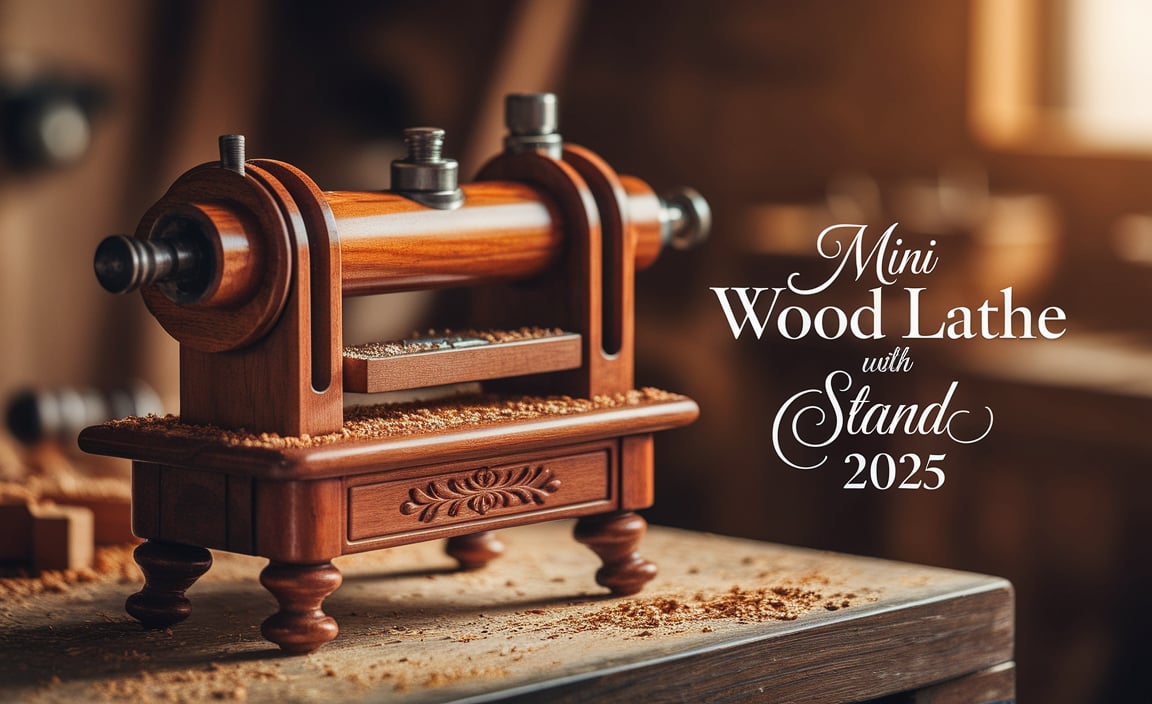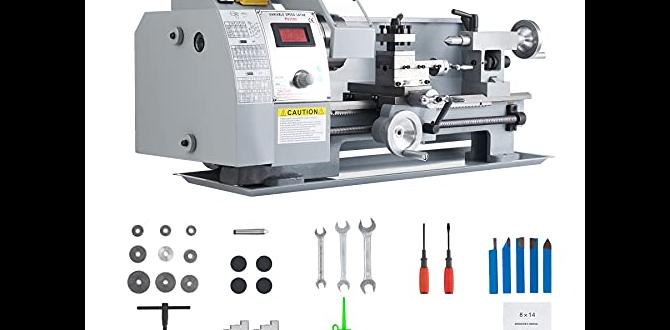A 3/16 inch carbide end mill is essential for MDF work because its size and sharp carbide edges deliver clean cuts, precise details, and durable performance on this challenging material, making it a go-to for hobbyists and pros alike.
Working with Medium-Density Fiberboard (MDF) can sometimes feel like a puzzle, especially when you’re aiming for those smooth, clean edges and intricate designs that really make your projects stand out. You might have noticed that standard bits can leave fuzzy lines or struggle to make precise cuts. It’s a common hurdle for many makers, but there’s a simple, effective solution waiting for you.
This guide is all about unlocking the power of a specific tool: the 3/16 inch carbide end mill. We’ll break down why this tool is a game-changer for MDF. You’ll learn exactly what makes it so good and how to use it to achieve professional-looking results in your own workshop. Get ready to transform your MDF projects with confidence and ease!
Why a 3/16 Inch Carbide End Mill is Your MDF’s Best Friend
Medium-Density Fiberboard (MDF) is a fantastic material for CNC routing and general woodworking. It’s affordable, smooth, and consistent. However, its composition – fine wood fibers mixed with resin – can present some unique cutting challenges. This is where the right tooling becomes absolutely critical.
Think of MDF like very fine dust compressed together. When a cutting tool encounters this, it needs to be sharp enough and strong enough to slice through cleanly without tearing or snagging the fibers. Standard high-speed steel (HSS) bits can work, but they tend to dull faster and can produce a rougher finish on MDF, especially with detailed work or when cutting at higher speeds.
This is precisely why a carbide end mill, and specifically a 3/16 inch one, becomes so valuable.
The Magic of Carbide
Carbide, or more formally, tungsten carbide, is an extremely hard and dense compound. Carbide cutting tools are made by sintering (a high-temperature, high-pressure process) powdered tungsten carbide with a binder, typically cobalt. This creates a material that is significantly harder and more wear-resistant than steel.
For MDF, this hardness means:
Superior Edge Retention: Carbide bits stay sharp for much longer than HSS bits. This is vital for consistent results and reduces the frequency with which you need to sharpen or replace your tools.
Heat Resistance: Cutting generates friction and heat. Carbide can withstand higher temperatures without softening, which helps maintain the cutting edge and prolongs tool life.
Clean Cuts: The inherent sharpness and rigidity of carbide allow it to slice through MDF fibers cleanly, minimizing tear-out and producing smooth, almost polished surfaces right off the mill.
The Significance of the 3/16 Inch Diameter
The 3/16 inch (approximately 4.76 mm) diameter is a sweet spot for many MDF applications, especially for DIYers and hobbyists using desktop CNC machines or even hand-held routers.
Detail Capability: This size is small enough to enable relatively fine details, intricate lettering, and complex patterns without being so tiny that it becomes fragile or prone to breaking easily. For example, cutting out small decorative elements or engraving fine text becomes very manageable.
Balance of Strength and Agility: While smaller than larger end mills, a 3/16 inch end mill offers a good balance. It’s robust enough for general cutting tasks, such as sizing panels or cutting out parts, but agile enough for more delicate work. This versatility makes it a workhorse in the workshop.
Reduced Neck for Tight Tolerances: Some 3/16 inch carbide end mills come with a “reduced neck.” This feature means the shank (the part that goes into the collet) is slightly larger than the cutting diameter. This provides extra strength and rigidity, crucial when you need to hold very tight tolerances or are performing demanding cuts where deflection could be an issue. A reduced neck is especially beneficial for detailed work where precision is paramount.
What to Look For in a 3/16 Inch Carbide End Mill for MDF
Not all carbide end mills are created equal, and some are specifically better suited for MDF. When you’re shopping, keep these features in mind:
Number of Flutes: For MDF, you’ll typically want an end mill with two or three flutes.
Two-flute cutters are excellent for plastics and composite materials like MDF. They offer good chip clearance, which is important because MDF produces a lot of fine dust. More chip room means less recutting of chips, less heat build-up, and a cleaner cut.
Three-flute cutters can also work well and offer a smoother finish than two-flute bits, but they can sometimes struggle more with chip evacuation in softer materials like MDF if not run at the right settings. For most MDF applications, two flutes are a safe and effective bet.
Coating: While not always essential for MDF, some coatings can further enhance performance and tool life. Uncoated carbide is often sufficient and cost-effective for MDF. If considering coatings, something like a TiCN (Titanium Carbonitride) coating can add a bit more wear resistance and lubricity.
Helix Angle: A steeper helix angle (often around 30-45 degrees) is generally good for softer materials like MDF. It helps with chip evacuation and can lead to a smoother cut.
Ball Nose vs. Flat End:
A flat-bottom end mill is ideal for cutting out shapes and creating pockets with square corners (though perfect square corners are rare due to the tool’s radius).
A ball nose end mill is essential for carving contours, creating rounded edges, and 3D sculpting. A 3/16 inch ball nose end mill is perfect for adding detail and texture.
Shank Diameter: Most desktop CNC machines and many routers commonly use a 1/4 inch (6.35 mm) or 8 mm collet. Ensure the shank diameter of your end mill matches your machine’s collet. You’ll often find 3/16 inch cutting diameter end mills with an 8 mm or 1/4 inch shank. Some specialized mills might have a reduced neck for increased rigidity, meaning the cutting diameter (3/16 inch) is smaller than the shank diameter (e.g., a 1/4 inch shank).
Getting Started: Setting Up Your 3/16 Inch Carbide End Mill
Proper setup is just as important as the tool itself. Whether you’re using a CNC router or a hand-held router for template work, following these steps will ensure success.
For CNC Routing MDF
When using your 3/16 inch carbide end mill on a CNC router, precision in your settings is key. MDF can be abrasive, so using the right speeds and feeds will prolong your tool life and give you the best finish.
Essential Settings for MDF:
Spindle Speed (RPM): A good starting point for a 3/16 inch carbide end mill in MDF is typically between 18,000 and 24,000 RPM. Higher RPMs can lead to cleaner cuts but also generate more heat. You might need to experiment based on your specific machine and MDF density.
Feed Rate: This is how fast the tool moves through the material. For a 3/16″ two-flute end mill, a feed rate of around 40-80 inches per minute (IPM) or 1000-2000 mm per minute is a common range. This needs to be balanced with your RPM. A common calculation is chip load: `Feed Rate = Chip Load x Number of Flutes x Spindle Speed (in Hz)`. A good chip load for MDF with a 3/16 inch end mill is often between 0.003″ and 0.006.
Depth of Cut (DOC): For a 3/16 inch end mill in MDF with a standard rigid CNC, a depth of cut between 0.125 inches (3 mm) and 0.25 inches (6 mm) is usually safe. Avoid taking too deep of a cut, as this can overload the tool and lead to a poor finish or broken bit. For very detailed work or thinner material, you might use shallower depths.
Plunge Rate: This is how fast the end mill moves down into the material. It should be significantly slower than your feed rate, typically 1/3 to 1/2 of your XY feed rate, so around 20-40 IPM or 500-1000 mm per minute. This prevents the bit from overheating as it enters the material.
Tip: Always perform a “test cut” on a scrap piece of MDF. This allows you to listen to the sound of the cut, feel the vibration, and inspect the cut quality without risking your main project. Adjust speeds and feeds as needed. A good cut sounds like a consistent “hissing” or “crisp slicing” sound, not a loud screaming or grinding.
For Hand-Held Router Work (Template Routing)
If you’re using a 3/16 inch end mill with a template, the principles are similar, but you’re in direct control of the movement.
Steps for Template Routing with MDF:
1. Secure Your Workpiece: Ensure the MDF you are cutting is firmly clamped or secured to your workbench. Any movement can lead to dangerous situations and ruined cuts.
2. Prepare Your Template: Create your template from a sturdy material like 1/4 inch or 1/2 inch MDF, plywood, or acrylic. The template should have the desired shape. Ensure the edges that the router bit will follow are smooth and free of burrs.
3. Install the End Mill:
Turn off your router.
Insert the 3/16 inch carbide end mill into the router’s collet.
Tighten the collet securely using the appropriate wrenches. Make sure the shank of the end mill is properly seated in the collet.
4. Set the Cutting Depth:
Place the router on your workpiece (without the template initially) where you want to make a cut.
Turn on the router.
Slowly lower the router bit until it just touches the surface of the MDF.
Turn off the router.
Adjust the router’s depth setting to achieve your desired cut depth. For template routing, you usually want the bit to cut slightly deeper than the thickness of your template material, so it cuts into the workpiece just the right amount. A common setup is to have the template guide bearing ride on the template and the cutting edge of the end mill cut the workpiece to the full desired depth.
5. Position and Route:
Place your template over the workpiece.
Position the router so the bearing (if using a guide bearing bit) or the cutting edges of the bit are running against the edge of your template.
Turn on the router.
With a smooth, controlled motion, guide the router around the template. Keep constant contact between the router’s bearing and the template.
Work in a direction that pushes the cutter, known as climb cutting (pushing the router in the same direction the bit is rotating). This is particularly effective with carbide for a cleaner finish on MDF, but always exercise caution and ensure you have firm control. If unsure or uncomfortable, stick to conventional cutting (pushing against the rotation).
6. Clean Up: Once the cut is complete, turn off the router and remove it from the workpiece. Clean up any dust and debris.
Maintaining Your 3/16 Inch Carbide End Mill for Longevity
Even though carbide is tough, proper care will extend the life of your end mill and ensure it continues to perform optimally.
Cleaning
After each use, it’s essential to clean your end mill. MDF produces fine dust, which can cling to the flutes.
Compressed Air: This is the quickest and most effective method. Blow out any dust and debris from the flutes and the cutting edges.
Brush: A stiff-bristled brush (like a brass brush) can help dislodge stubborn dust.
Solvent (if necessary): For any resin build-up or sticky residue, a mild solvent like isopropyl alcohol can be used with a brush or cloth. Ensure the end mill is dry afterward.
Inspection
Periodically inspect your end mill for signs of wear or damage.
Chipping: Look for any small chips or nicks on the cutting edges.
Galling/Build-up: Check if any material has fused to the cutting surfaces.
Straightness: Ensure the shank and cutting flute are still straight.
If you notice significant damage or dulling, it’s time to consider resharpening or replacement.
Storage
Proper storage prevents damage and corrosion.
Tool Holders: Use dedicated tool holders or plastic sleeves to protect the cutting edges and shanks.
Dry Environment: Store your end mills in a dry place to prevent rust, especially if they are not coated.
Resharpening vs. Replacement
Resharpening: Carbide end mills can be resharpened, but it requires specialized grinding equipment and expertise. For smaller, affordable bits like the 3/16 inch size, especially if you’re a hobbyist, it’s often more practical and cost-effective to replace the bit when it becomes dull or damaged. For high-performance or larger carbide tools, professional resharpening is a common practice.
Replacement: When your end mill has dull edges, visible chipping, or starts producing a rough finish that cleaning and inspection can’t fix, it’s time for a new one. The cost of a new 3/16 inch carbide end mill is generally low enough that it’s a worthwhile investment to ensure clean cuts and prevent frustration.
Project Ideas Using a 3/16 Inch Carbide End Mill on MDF
This versatile tool opens up a world of possibilities for your MDF projects. Here are a few ideas to get your creativity flowing:
Detailed Signage: Cut out intricate lettering, logos, or decorative borders for custom signs. A 3/16 inch ball nose end mill is excellent for creating dimensional lettering.
Inlays and Accents: Create precise pockets in one piece of MDF to inlay a contrasting material or another piece of shaped MDF.
Speaker Boxes and Enclosures: Cut out precise shapes for speaker baffles, mounting holes, and porting for custom audio projects.
Organizational Drawer Inserts: Design and cut custom dividers and trays to perfectly fit your drawers and tools.
Artistic Carvings and Reliefs: Use a ball nose 3/16 inch end mill on your CNC to carve detailed 3D reliefs or shallow artistic patterns into MDF panels.
Jewelry and Craft Projects: Cut out small, precise shapes for decorative items, jewelry components, or stencils.
Model Making: Create detailed components for architectural models, dioramas, or scale replicas.
The ability to achieve smooth surfaces and sharp details with a 3/16 inch carbide end mill makes it an indispensable tool for anyone working with MDF.
Comparing 3/16 Inch Carbide vs. Other Tooling for MDF
Understanding how your 3/16 inch carbide end mill stacks up against other options can help you make informed decisions for different tasks.
Carbide vs. High-Speed Steel (HSS)
| Feature | 3/16″ Carbide End Mill | 3/16″ HSS End Mill |
| :————- | :————————————————— | :————————————————– |
| Hardness | Very High (Excellent wear resistance) | Moderate (Dulls faster than carbide) |
| Edge Life | Long lasting | Shorter lasting |
| Heat Tolerance | High (Resists softening at higher temps) | Lower (Can soften and deform with excessive heat) |
| Cost | Generally higher initial cost | Lower initial cost |
| Finish on MDF | Typically cleaner, smoother, less tear-out | Can be good, but prone to fuzziness and wear |
| Best For | Consistent, high-volume production, detailed work, demanding materials | Light-duty tasks, occasional use, when cost is primary concern |
Carbide vs. Different Flute Counts
2-Flute: Ideal for MDF due to excellent chip clearance. It helps prevent the fine MDF dust from packing into the flutes, reducing the risk of overheating and achieving a cleaner cut.
3-Flute: Offers a slightly smoother finish but can be more prone to chip packing in MDF if speeds and feeds aren’t perfectly optimized. It’s a good option if chip evacuation isn’t a major concern (e.g., shallow engraving) or if you’re running with strong air blast or dust collection.
4-Flute: Generally too many flutes for MDF. They offer less chip clearance and can lead to overheating and poor finishes because the fine MDF dust has nowhere to go.
Carbide vs. Larger Diameter End Mills
A larger end mill (e.g., 1/4 inch or 1/2 inch) will cut MDF faster for general sizing and removing material. However, it sacrifices the ability to perform fine details, engrave small text, or cut intricate patterns. The 3/16 inch size strikes a perfect balance for projects that require both general cutting and detailed work.
Common Issues and Troubleshooting with MDF and End Mills
Even with the best tools, you might encounter some snags. Here’s how to handle common problems that arise when cutting MDF.
Fuzzy Edges or Tear-Out
Cause: Dull end mill, incorrect feed rate (too slow), too shallow of a depth of cut, or poor chip evacuation.
Solution:
* Ensure your end mill is sharp. If not, replace or resharpen.







